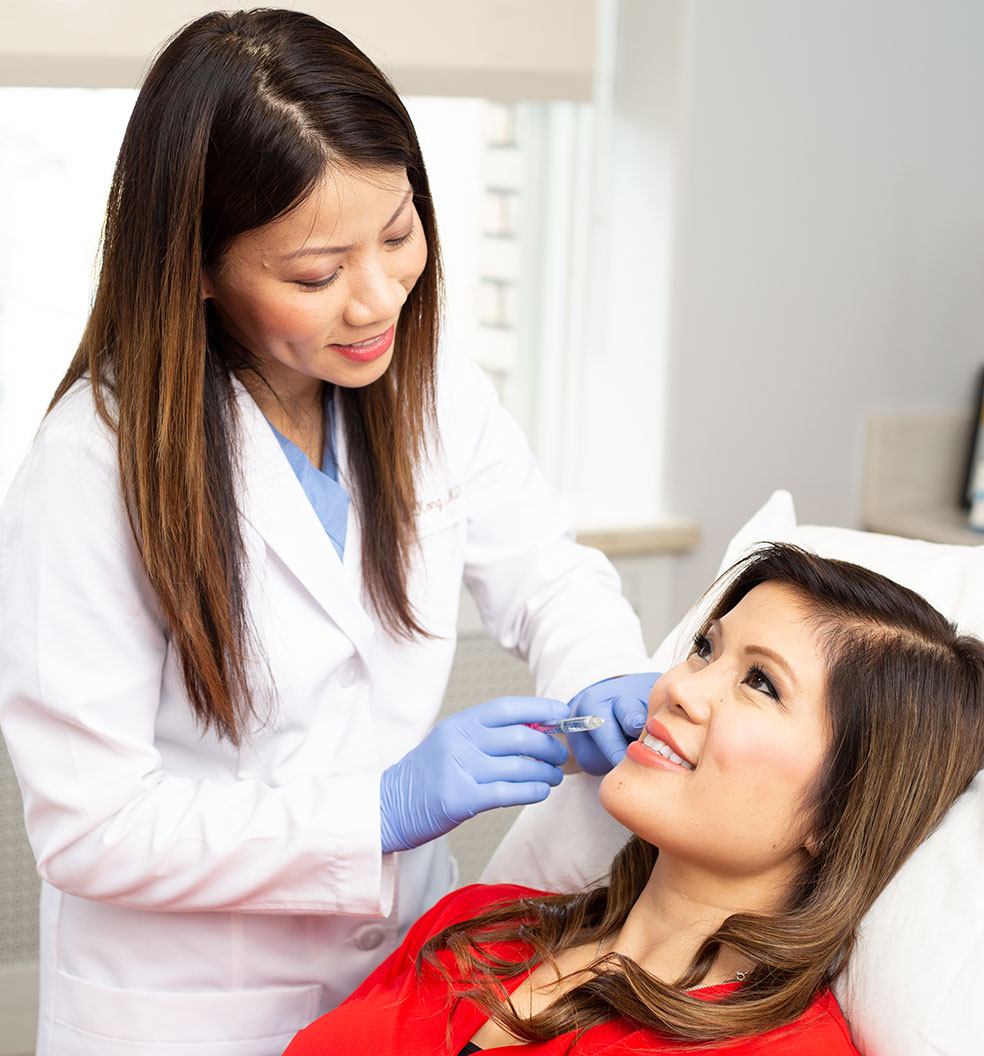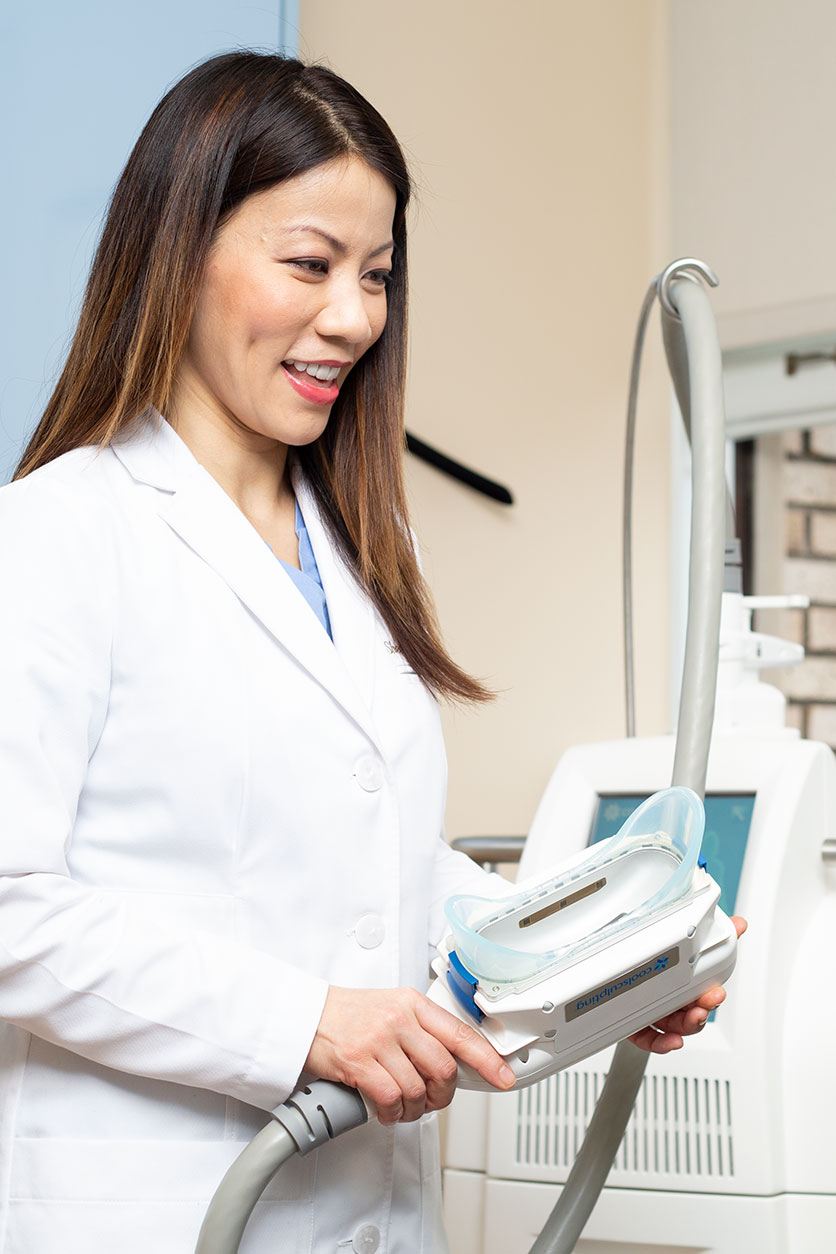My Approach to Treatment: Educating the Patient
I believe that patient education is an important foundation in establishing a healthy relationship between physician and patient. This is an important step to help patients to adopt a lifestyle and choose the most effective treatment. An understanding of the factors that lead to facial aging helps to build realistic expectations in a patient regarding the effect of the treatments they receive, as well as satisfaction and long-term trust in the physician – the educator.
Many times, I have found myself in the same scenario where the patient came to my office asking for a specific facial rejuvenation treatment, which turned out to be the least beneficial treatment to the patient, in my opinion. In my consultations, I explain to my patients how aging gradually affects the facial skin and tissue. In order to look younger naturally, we would have to understand the aging process specific to each patient to restore and rejuvenate the skin appropriately for the condition. I have found it fun and rewarding to educate my patients. I would like to share what I know to help anyone who has concerns about aging skin.

Volume
Lost Facial Volume: The Options
When we are young, we have an even distribution of soft tissue and a fat layer beneath the facial skin. As we get older, we experience various degrees of facial fat loss in different areas of the face as well as changes in facial bone structure. In some areas of the face, facial fat pockets may become more visible as the surrounding facial structure becomes thinner and less supportive.
From a frontal view, facial volume loss can be seen as one develops thinner and darker tissue beneath the eyes, or the facial fat starts to bulge, creating undereye bags.
Loss of volume can also be seen as the cheek fat pads moving on the facial structure, drifting to the front and down to create deeper nasolabial folds, commonly known as “smile lines.” One may also develop upper and lower lip lines, as the lip volume diminishes over time. At the jawline, facial volume loss often leads to the appearance of jowls, as the facial fat pads move downward, with loss of surrounding facial fat support.
There is little that can be done to naturally to halt facial fat loss. However, there are positive lifestyle changes make a difference, such as facial muscle exercises as well as maintaining good dental health to prevent bone and teeth loss. One can also use dermal fillers such as Juvéderm Voluma XC or nanofat transfer to replace facial volume loss for a long-term result.
Firmness
Aging and Facial Firmness
As young as we are in the mid-twenties, the loss of hyaluronic acid has already begun. Hyaluronic acid is an essential element in skin structure, keeping it plump and hydrated. Hyaluronic acid is also essential in facilitating natural collagen production. As we age further into our 30s and 40s, the skin begins to lose collagen and elastin, both of which play a key role in structural firmness and elastic recoil quality of skin.
With loss of some facial volume, the first signs of diminished facial firmness start to appear. As we age, bone volume is also lost, leading to changes in definition of jawbone and chin. In addition, our neck muscle (platysma muscle) starts to contract more in order to support the neck and the base of the mouth, creating a downward pull on the face.
We also lose the strength of facial ligaments that support the sides of the jaw. We now have a less-defined jawline, jowls and excessive skin altering the appearance of the lower face. This typically can be seen as one develops “marionette lines” extending from the corners of mouth and downward around the chin. Deeper smile lines may also appear. These lines may be the result of facial volume loss or a combination of these two aging factors.
Advances in Skin Science
Skin science has been focused on developing skincare key ingredients to replenish hyaluronic acid and regenerate collagen and elastin. One of my favorite skincare lines is Neocutis, which provides micro peptides to the skin layers to trigger natural collagen and elastin regeneration. Skin tightening treatments such as Thermage and Ultherapy also generate a natural increase in collagen production in the deeper layers of skin to slow the process of aging.
One should also make lifestyle decisions to avoid significant weight gain and loss, as it can cause a loss of skin firmness. Great skincare, hydration, less stress and more beauty sleep can also help to slow the loss of skin firmness and allow one to age gracefully.
Suncare
Chronic Sun Exposure and Skin Quality
It is impossible to avoid sun exposure. In addition, who can refuse a gorgeous suntan on the beach, as well as all these wonderful outdoor activities that bring us closer to nature?
UVA and UVB penetrate and create free radicals within the skin cells. Over time, these free radicals break down collagen and elastin, creating fine lines and wrinkles on our faces, and pigments begin to form. Forehead wrinkles as well as creases between the brows, eyebrows, crow’s feet, upper lip wrinkles and side cheek wrinkles come about due to chronic sun exposure, as skin in these areas are naturally thinner, and UV ray exposure has a bigger impact in creating fine wrinkles. The harmful effect of long term sun exposure is more than skin deep. Skin cancer is the ultimate health threat related to extensive sun exposure.
It’s important to use sunscreen, to prevent wrinkle formation and to avoid developing skin cancer. It is also important to add an effective topical vitamin C serum as an added protection. Laser treatments, such as Fraxel Dual can restore smoother, firmer, more evenly-toned skin quality if the facial skin has been damaged by sun exposure.
Symptoms of Aging Facial Skin

Forehead lines
Lines, wrinkles, and creases on the brow are the result of diminished along with facial movements creating expressions with muscle contraction, as well as exposure to sun.
Eye Bags, Hollow or Dark
This sign of aging is the result of thinning skin tissue around the eyes, which creates a hollow appearance, along with a darker hue beneath the eyes.
Puffy Eye Bags
This is caused by facial fat pad beneath the eyes moving forward and downward as loss of support from surrounding tissue. This sign of aging is associated with loss of facial volume, even though the bulging fat pads suggest otherwise.
Crow’s Feet
Fines lines and wrinkles surrounding the eyes may be caused by loss of collagen in the skin, UV exposure as well as strong repetitive muscle contractions when smiling or squinting.
Smile lines
This refers to nasolabial folds. As the skin loses firmness or loses volume, creases start to appear from nose to sides of mouth.
Upper lip lines
A network of fines lines above the upper lip comes about through volume loss, reduced collagen production, and sun exposure.
Side cheek lines
This refers to lines on the corners of mouth or more commonly on the sides of low cheeks. This is mostly due to chronic UV exposure in a fair-skinned person. This may also be associated with jowls as the entire jawline begins to sag due to collagen loss.
Lower mouth lines
This is also called “marionette lines.” These lines extend to the chin, typically the result of skin becoming lax on the lower face.
Jowls
This is developed as one develops scallops along the jawline, with the jaw losing definition. This comes about due to skin losing its strength, structure and firmness.
Neck lines
Horizontal neck lines appear as the skin on the neck loses its resiliency and the muscles and tendons begin to be visible. This condition can be made more evident in people with excessive neck fat or a congenital uneven distribution of the natural fat pads on the neck.
Rate Us!
Please take a moment to rate your experience
with our team.



